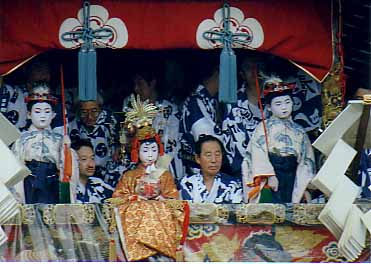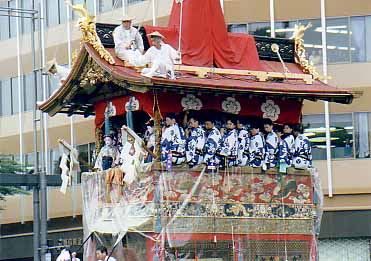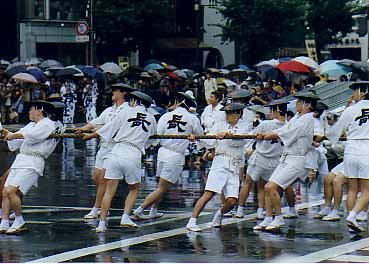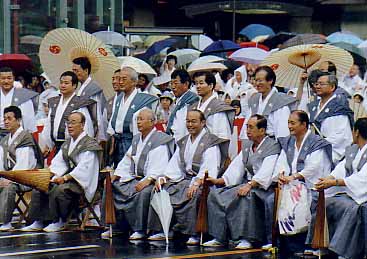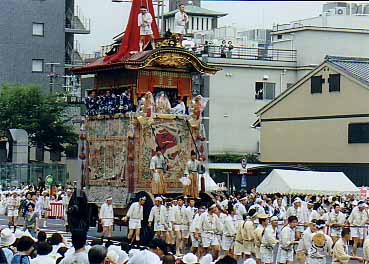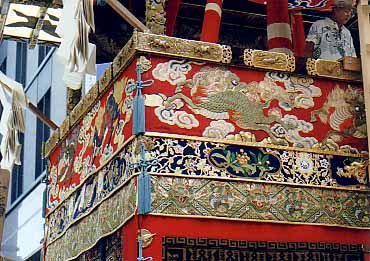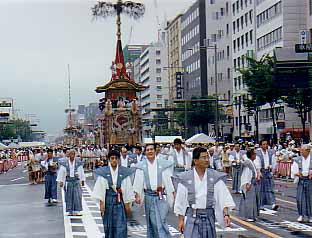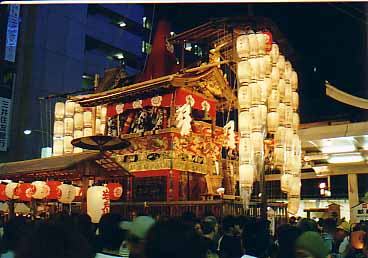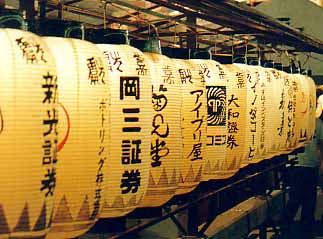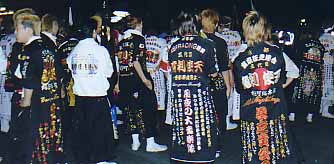
| Main Page |
| Photo Galleries |
| Writing |
| Aikido |
| Zen |
| Peeps |
| Links |
| Contact |
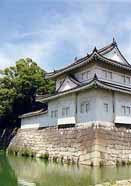
Gion Festival
|
The chosen children lead the parade inside their enormous 'boko' float as it is pulled down Kawaramachi Street. |
Kyoto's Gion Festival is truly a sight to behold, and although it is difficult to sum up what is, in truth, a month-long festival...here are the highlights.
The days of the 13th-16th of the month were the high points of the festival, which culminates in a parade through downtown Kyoto.
The parade has been going on since the early 800's (no, not 1800's...800's) and was originally intended as a way of begging for intervention from the gods into various trials of the times (war, plague, etc., etc...you know, the usual)
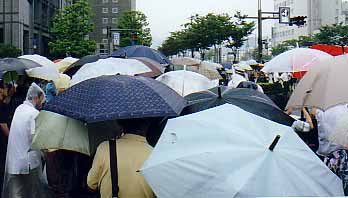 When
we first arrived on parade day, I had some requests from the gods myself...namely
that a) it would stop raining so hard, and b) that the legions of umbrella
wielding spectators blocking my view would be struck down by some righteous
display of heavenly wrath (has nobody here heard of a raincoat?). Since
no such spectacle seemed forthcoming...I took to higher ground...scaling
a traffic light and wedging myself between two poles for a better look
(how I suffer for my art!). A telephoto-feeding frenzy ensued.
When
we first arrived on parade day, I had some requests from the gods myself...namely
that a) it would stop raining so hard, and b) that the legions of umbrella
wielding spectators blocking my view would be struck down by some righteous
display of heavenly wrath (has nobody here heard of a raincoat?). Since
no such spectacle seemed forthcoming...I took to higher ground...scaling
a traffic light and wedging myself between two poles for a better look
(how I suffer for my art!). A telephoto-feeding frenzy ensued.
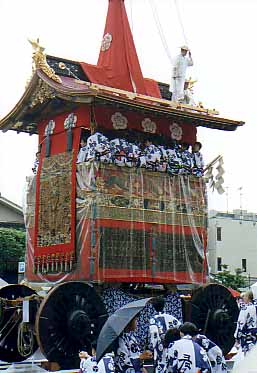 The
bokos themselves are like giant medieval siege engines and are of genuinely
impressive proportions. They are built like enormous carts, and are
made in the traditional fashion; there are no nails holding these together,
just rope. You really get a feel for that as they shudder into motion,
and it is in part what makes turning them so exciting.
The
bokos themselves are like giant medieval siege engines and are of genuinely
impressive proportions. They are built like enormous carts, and are
made in the traditional fashion; there are no nails holding these together,
just rope. You really get a feel for that as they shudder into motion,
and it is in part what makes turning them so exciting.
The wheels are fixed, which obviously makes steering, and especially turning, unbelievably difficult. Slight adjustments are made by ramming wedges under the wheels while they are moving. This often results in dramatic swaying of the boko, and it gives the impression that the whole thing will lurch over, spilling its occupants into the crowd below.
But that says nothing about the turning. At a few points in the parade, these things actually have to make 90 degree turns. This is truly the highlight of the parade, as a virtual army of men are deployed to haul the boko around.
|
Everyone looks (nervously?) below as the bamboo slats are put in place for the first big turn |
Bamboo slats are placed under the wheels of the boko and the ropes attached to the front of the boko are drawn far off to the side of the float.
In a series of heroic bursts of human might, the float is jerked and dragged around the corner (I'd hate to be one of the guys on the roof for this part).
The whole affair is conducted to the thunderous applause of the audience, which surrounds the intersection, standing in rapt attention.
|
Pulling for dear life. How they do this wearing thong sandals, I'll never know. |
When it comes to the actual hauling, the men step up to the plate wearing nothing like the bear-claw-cleats you'd expect them to be sporting when facing such a task. Watching them put there backs into the first great pull, I found myself wondering uneasily if some awful person had stolen all of their shoes just before this fateful parade.
Everyone seemed to have a great time, myself included (despite the fact that I was securely wedged in the traffic lights and was getting drenched as thousands of Japanese spectators stared at my bum) and the floats made the big turn with minimal carnage.
|
The parade vanguard watches with appreciation as the Chosen Ones in the first float are hauled around the corner to what I was sure would be their death. |
I was asked to kindly extricate myself from the poles with which I had become so fondly aquainted, and we skipped merrily along to get ahead of the parade which was now progressing along at a snail's pace.
Getting ahead was not too difficult. Each of the giant floats in the parade had to make the same turn, and meanwhile the rest of the parade would wait patiently ahead. The pace of the parade has not changed in 1100 years, and it certainly wasn't going to speed up on our account.
|
The parade progresses down Shijo Street, each hoko being hauled by long lines of Japanese. Inside the float, musicians bang away traditional tunes for all to enjoy (put mouse over image to zoom in). |
As we moved ahead we found we had a fuller appreciation of just how huge a production this parade really was, and I began to get an idea of why these floats and those who tend to them seem to be held in such reverence.
Each float is, in its own way, a national treasure. That many of the decorations are even allowed to see the light of day is testament to the importance of the parade in Japanese culture.
While at first I found myself disappointed that many of the floats were covered with plastic sheeting, my mind was quickly changed as I learned of the age and importance of the tapestries which the plastic was protecting.
|
Check the detail on this one. Each float is remarkable for its stunning detail, and many of the tapestries involved in the parade are national treasures that for any other reason would never make it out of a museum (roll mouse over image for more detail) |
This, in part, explains the festive atmosphere that surrounds the entire festival (that sounds stupid, I suppose, saying that a festival has a festive atmosphere...but that's my wording and I'm sticking to it).
For the last few nights before the parade, the streets at night are thronging with people out to see the floats up close before the big event.
For a small fee, curious sightseers can go up inside the various hokos. This is a particular treat for women, who are otherwise not allowed the honour of going inside the floats. In fact, floats aside, women do not participate in the parade at all. If you scan back over the pictures above, you'll notice there's not a single women in the whole procession. Children yes, women no.
|
It's a man's world: not a single woman in the parade...and that's by design. Only men are allowed to participate. |
But I digress. As I was saying, the nights are full of music, food, crowds and lots of fun. The hoko's are all lit up and eager masses flock to see them.
The festival attracts an interesting cross section of Japanses society, as people gather from across the country for the event. In recent years, Japan's underworld has been more colourfully represented, with gangs showing up waving banners of their own. I spotted a few Yajuza, myself, made unmistakable by the full-back tattoos (sorry, no pictures!).
|
The crowd is packed tight around the beautifully lit hoko. |
Laura managed a few shots of some gang members as they faced off with police at the end of the night in an amusing and childish act of defiance ("No, we won't move onto the sidewalk! We're young and rebellious! Oh, I see you have clubs and shields...right you are. We'll be moving right along.").
All in all, the festival was a blast, and it was an interesting way to see a small part of Japan's history as well.
Although Kyotoites lament the inconvenience of the crowds, I think this festival is still a central part of their consciousness, and another reason why - in some small way - the people of Kyoto still believe this city to be the heart and soul of the country.
|
|
